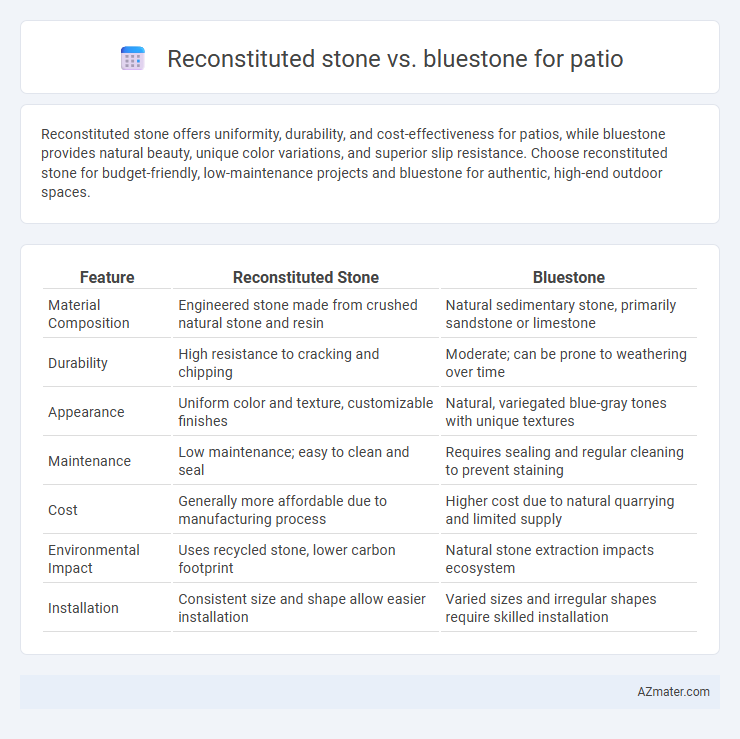Reconstituted stone offers uniformity, durability, and cost-effectiveness for patios, while bluestone provides natural beauty, unique color variations, and superior slip resistance. Choose reconstituted stone for budget-friendly, low-maintenance projects and bluestone for authentic, high-end outdoor spaces.
Table of Comparison
| Feature | Reconstituted Stone | Bluestone |
|---|---|---|
| Material Composition | Engineered stone made from crushed natural stone and resin | Natural sedimentary stone, primarily sandstone or limestone |
| Durability | High resistance to cracking and chipping | Moderate; can be prone to weathering over time |
| Appearance | Uniform color and texture, customizable finishes | Natural, variegated blue-gray tones with unique textures |
| Maintenance | Low maintenance; easy to clean and seal | Requires sealing and regular cleaning to prevent staining |
| Cost | Generally more affordable due to manufacturing process | Higher cost due to natural quarrying and limited supply |
| Environmental Impact | Uses recycled stone, lower carbon footprint | Natural stone extraction impacts ecosystem |
| Installation | Consistent size and shape allow easier installation | Varied sizes and irregular shapes require skilled installation |
Introduction to Patio Paving Materials
Reconstituted stone and bluestone are popular patio paving materials known for durability and aesthetic appeal. Reconstituted stone, made from crushed natural stone mixed with cement, offers a versatile and cost-effective alternative with consistent color and texture. Bluestone, a dense, fine-grained sandstone, provides natural slip resistance and rich, earthy tones that enhance outdoor spaces with timeless elegance.
What Is Reconstituted Stone?
Reconstituted stone is an engineered material made from crushed natural stone mixed with resin and pigments, designed to mimic the appearance and texture of natural stone while offering enhanced durability and uniformity. Unlike bluestone, which is a natural sedimentary rock known for its distinctive blue-gray color and natural variation, reconstituted stone provides greater consistency in size, shape, and color, making it ideal for precise patio installations. Its resistance to cracking and weathering makes reconstituted stone a practical and cost-effective alternative for outdoor patios compared to bluestone.
What Is Bluestone?
Bluestone is a dense, durable natural stone primarily quarried in the northeastern United States, known for its rich blue-gray hues and unique, variegated texture making it a popular choice for patios due to its slip-resistant surface. Reconstituted stone, on the other hand, is man-made using crushed natural stone mixed with resin or cement, allowing for uniform sizes and shapes but lacking the natural variation and authenticity of bluestone. Bluestone offers superior weather resistance and timeless aesthetic appeal, making it a preferred material for high-end outdoor patio installations.
Appearance and Aesthetic Differences
Reconstituted stone offers a uniform appearance with consistent color and texture, mimicking natural stone while allowing for a wider range of design options and finishes. Bluestone, a natural sedimentary rock, showcases unique variegated shades of blue and gray with irregular patterns, providing a timeless and organic aesthetic ideal for rustic or traditional patios. The choice between the two depends on the desired look, with reconstituted stone offering predictability and bluestone delivering authentic natural beauty.
Durability and Strength Comparison
Reconstituted stone offers superior uniformity and strength due to its engineered composition, making it highly resistant to cracking and weathering. Bluestone, a natural sedimentary rock, provides excellent durability with a dense structure but may be prone to chipping and surface erosion over time. Both materials withstand outdoor conditions well, but reconstituted stone typically delivers greater long-term resilience for patio applications.
Cost and Budget Considerations
Reconstituted stone offers a cost-effective alternative to natural bluestone, typically costing 30-50% less, making it ideal for budget-conscious patio projects. Bluestone, a natural quarried stone, commands a higher price due to extraction and transportation costs, with prices ranging from $15 to $25 per square foot, compared to $8 to $15 for reconstituted stone. Factoring in installation and long-term durability, reconstituted stone may reduce upfront expenses while bluestone's natural aesthetic and longevity might justify its premium cost depending on project priorities.
Installation Process and Maintenance Needs
Reconstituted stone patios offer easier installation due to uniform size and shape, which allows for quicker, more precise laying compared to natural bluestone's irregular slabs that require skilled fitting and leveling. Maintenance for reconstituted stone involves regular sealing to prevent staining and color fading, while bluestone demands periodic cleaning and sealing to preserve its natural look and resist weathering. Both materials benefit from prompt removal of debris and occasional joint refilling, but bluestone may need more frequent attention to avoid moss and algae growth in shaded or damp areas.
Environmental Impact and Sustainability
Reconstituted stone offers a sustainable alternative to natural bluestone by utilizing recycled materials and reducing quarrying-induced habitat destruction. Bluestone extraction involves significant environmental disruption, including soil erosion and energy-intensive processing, whereas reconstituted stone manufacturing often incorporates eco-friendly binders and less energy consumption. Choosing reconstituted stone for patios supports lower carbon footprints and promotes resource conservation compared to traditional bluestone options.
Best Applications for Reconstituted Stone vs Bluestone
Reconstituted stone is best suited for patios requiring uniformity, consistent color, and customizable shapes due to its engineered composition, making it ideal for modern or structured designs. Bluestone excels in applications prioritizing natural aesthetics, durability, and slip resistance, with its genuine stone texture enhancing traditional or rustic outdoor spaces. For durability under heavy foot traffic and diverse weather conditions, reconstituted stone offers enhanced strength, while bluestone is preferred for rustic charm and natural variation.
Conclusion: Choosing the Best Stone for Your Patio
Reconstituted stone offers uniformity, cost-effectiveness, and a wide range of design options, making it ideal for budget-conscious projects with specific aesthetic goals. Bluestone boasts natural durability, rich color variations, and superior weather resistance, perfect for homeowners seeking authentic, long-lasting outdoor spaces. Selecting the best stone depends on prioritizing factors like budget, appearance, maintenance, and climate resilience tailored to your patio needs.

Infographic: Reconstituted stone vs Bluestone for Patio
 azmater.com
azmater.com